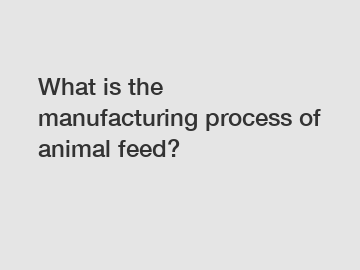What is the manufacturing process of animal feed?
Animal feed plays a crucial role in providing the necessary nutrition for livestock and poultry to grow, develop, and maintain good health. The manufacturing process of animal feed involves a series of steps to produce high-quality feed that meets the nutritional requirements of various animals. This article explores the manufacturing process of animal feed and the steps involved in producing nutritious and balanced feed for livestock and poultry.
**Grinding and Mixing**.
The first step in the manufacturing process of animal feed is grinding and mixing. During this process, various raw materials such as grains, oilseeds, and protein sources are ground to a specific particle size to improve digestibility and nutrient absorption. Grinding helps break down the raw materials into smaller particles, making it easier for animals to digest and absorb the nutrients. Once the raw materials are ground, they are mixed together to create a balanced feed formula that meets the nutritional requirements of the animals.

**Pelletizing**.
After grinding and mixing the raw materials, the next step in the manufacturing process is pelletizing. Pelletizing involves compressing the feed mixture into pellets using a pellet mill. The pellets are then extruded through a die to give them a specific shape and size. Pelletizing helps improve feed efficiency, reduce waste, and increase the palatability of the feed. It also helps prevent the feed from being easily blown away or wasted by animals.
**Cooling and Crumbling**.
Once the pellets are formed, they are cooled to reduce their temperature and moisture content. Cooling the pellets helps improve their shelf life and prevents them from becoming moldy or spoiling. After cooling, the pellets are crumbled into smaller pieces using a crumbler or crusher. Crumbling the pellets helps improve feed digestibility and consumption, especially for animals with smaller mouths or weaker teeth.
**Screening and Packaging**.
The final steps in the manufacturing process of animal feed involve screening and packaging. The crumbled feed is screened to remove any fines or dust particles that may affect the quality of the feed. Once the feed is screened, it is either bagged or stored in bulk containers for distribution to farms, feed mills, or retailers. Packaging plays a crucial role in preserving the quality and freshness of the feed, ensuring that it reaches the animals in optimal condition.
In conclusion, the manufacturing process of animal feed involves several essential steps, from grinding and mixing the raw materials to pelletizing, cooling, crumbling, screening, and packaging the feed. Each step is crucial in producing high-quality feed that meets the nutritional requirements of various animals. By following these steps and ensuring quality control measures are in place, feed manufacturers can produce nutritious and balanced feed that contributes to the health and well-being of livestock and poultry.
If you have any questions about the manufacturing process of animal feed or would like to learn more about our products, please feel free to contact us.
Want more information on pellet coater, feed pellet grading sieve, pelleting aids for animal feed? Feel free to contact us.
120
0
0


Comments
All Comments (0)